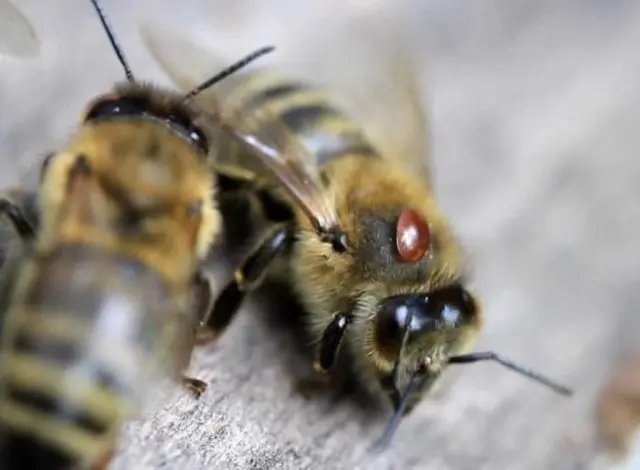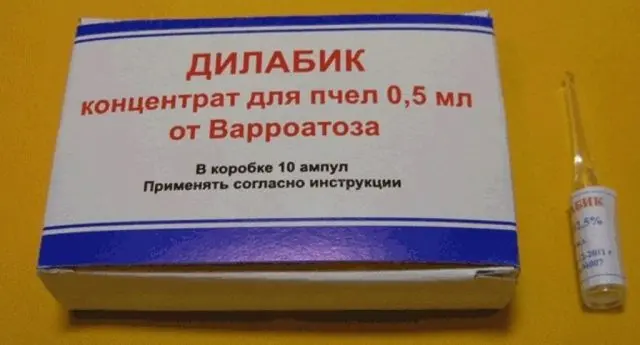Contents
Dilabik for bees, the instructions for use of which must be carefully read, is a medicinal product. Should be in the arsenal of every beekeeper who wants to see their furry pets healthy and viable. The most important enemy of bees is a tick, which can be eliminated by folk and medicinal means. Dilabik is considered the most effective drug.
Application in beekeeping
Dilabik for bees is a medicinal preparation used for preventive measures and the fight against varroatosis. To determine the disease, you must carefully examine the bees. In case of mite damage on the abdomen, cephalothorax of adult bees and on the body of pupae, small dark brown plaques can be seen.

Composition, form of release
Dilabik for bees is produced in a package of 10 ampoules with a volume of 0,5 ml.
The composition of 0,5 ml of the drug Dilabik includes 2 varieties of highly purified amitraz, which, with regular use, do not allow the tick to get used to this drug. When processing the frames by watering, the drug Dilabic is completely eaten by bees, without causing side effects and without being deposited in beekeeping products.
Pharmacological properties
Dilabik for bees is a substance of 2 amitraz isomers. According to the content of additional components, the medicine belongs to the 4th toxicity group, which meets the standard for use and contact with bee products.
Dilabik: instructions for use
According to beekeepers, Dilabik is effective in combating varroatosis and in carrying out preventive measures. For safety reasons, the treatment of hives is carried out with gloves and a respirator. Do not smoke, eat or drink while working. After finishing the treatment, wash your hands and face with hot water and soap.
Dosage, application rules
According to the instructions, Dilabik is used in autumn and spring. How to use:
- In autumn, the hive is treated 2 times: immediately after honey is pumped out and the bee family is prepared for wintering, the second – during the formation of the bee club, at an air temperature of + 3-10 ° C. A solution is prepared half an hour before the start of treatment. To do this, an ampoule of concentrate is lowered into 1 liter of warm boiled water and gently crushed.
- The solution is thoroughly mixed and drawn into a 10 cc syringe. The interframe space is shed with the medicine, using 10 ml for each street. Since the drug has a long-term effect, in the spring it will be enough to spend 10 ml of a solution prepared in a similar way for each frame.
- The drug Dilabik can be used by the method of fine spraying through an aerosol dispenser. To do this, the ampoule is dissolved in 1 liter of boiled water and the frames are treated on both sides with 5 ml.
- You can use a smoke gun. To do this, dissolve 8 ampoules of 0,5 ml in half a glass of warm water. For one family, 2-3 ml of the finished medicine is spent. It is served in the form of a thin stream of steam through the lower tray. Processing with a smoke gun is done 3 times, exclusively in the evening at a temperature of + 12-25 ° C. If printed brood is present, the interval between treatments should not be more than 5 days.
Side effects, contraindications, restrictions on use
From the instructions it can be seen that there are no contraindications for the drug Dilabik for bees. But in the summer, during the main honey plant, the drug is not recommended.

Shelf life and storage conditions
Dilabik is stored in a dark place protected from sunlight at a temperature of 0-20 °C. The shelf life is no more than 2 years from the date of production.
Conclusion
Before using Dilabik for bees, the instructions should be well studied. Since non-compliance with the rules of application and dosage can have a deplorable effect on the bee family. Breeding bees, you must remember that this is not only getting a tasty treat, but also a responsible job. The health of furry workers depends on proper care and timely preventive measures.









